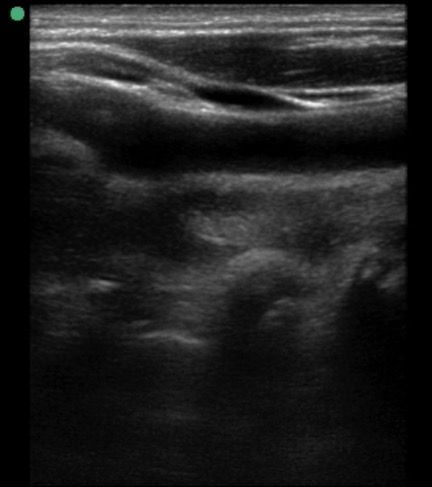History:
A 77 year old male with no known medical conditions presented to the emergency department (ED) with a chief complaint of food being stuck in his throat. He states that he was eating chicken 2 hours prior to arrival and felt it get stuck in his neck after swallowing. This has happened to him in the past, but he had always been able to either vomit the stuck food or to force it further down, but this time he was unable to. He is having a hard time managing his secretions and speaking but is otherwise asymptomatic.
Physical Exam:
AFVSS. He appears uncomfortable but not distressed. He is drooling & dysphonic.
He has a normal cardiopulmonary examination. He has no abdominal distention or tenderness. Throat exam reveals no abnormalities. External examination of the neck is normal, but the patient indicates that he feels the impacted food between his hyoid and cricoid.
Workup & Management:
A chest x-ray and soft-tissue neck (below)were performed and interpreted by radiology as essentially normal with no radiopaque foreign bodies. CBC and electrolytes were all within normal limits.
Point-of-Care Ultrasound:
Given that the radiographs were non-diagnostic in the setting of a patient who it was strongly suspected had an esophageal food impaction (i.e. high pre-test probability) a bedside ultrasound examination was performed. A parasagittal approach was utilized with the transducer oriented longitudinally with the probe placed just left of the mid-line (using the carotid artery as a sound window) revealed the presence of a soft tissue foreign body in the proximal-mid esophagus (below).
Video clip: Esophageal Food Impaction Parasagittal
Disposition:
Gastroenterology was consulted and the patient was taken to the endoscopy suite where he underwent an EGD and had the successful removal of a piece of chicken from the proximal-mid esophagus.
Wrap-up & Learning Points:
-radiographs can be notoriously unreliable in the detection of esophageal foreign bodies/food boluses with one meta-analysis showing a sensitivity range of 20-50% for the detection of swallowed bones
-there is very little published literature on using POC US to detect esophageal food impactions or foreign bodies. The normal esophagus is not seen using US.
Review article on upper airway ultrasound:
Prasad et al US Imaging of Airway CJA Airway anatomy Sing et






